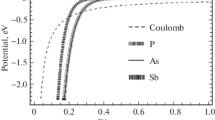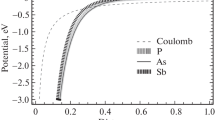Summary
A realistic model is set up in order to study the structure of the donor ground states in the semiconducting III-V compounds. The model is also applied to Si and gives results in agreement with those of Baldereschi. The lifting of the degeneracies, which are present in the effective-mass approximation, is shown to be due to the intervalley interaction of the impurity potential between degenerate minima and also between minima at different energy. The impurity states in GaAs are studied in detail as function of the energy separation between thek = 0 minimum and the subsidiary ones located atk = (2π/a)(1, 0, 0) etc. States of the same symmetry originating from those minima strongly interact, according to the noncrossing rule, when the energy separation is small and this produces a strong shift of the impurity states and a mixing of the wave functions.
Riassunto
Si studia in un modello realistico la struttura dello stato fondamentale e dei primi stati eccitati di un’impurezza donatore in un semiconduttore cubico del tipo III-V. Si trova che gli elementi di matrice del potenziale di impurezza tra stati legati associati a minimi diversi e degeneri nell’approssimazione delle masse efficaci sono responsabili delle strutture degli stati osservate. Inoltre si studia l’influenza sui primi stati della presenza nella banda di conduzione di un minimo ak = 0 e di tre minimi degeneri nei puntiX a energie differenti. La forma delle funzioni d’onda dei primi stati si studia al variare dell’energia di separazione tra i minimi.
Резюме
Предлагается реалис тическая модель для т ого, чтобы исследоват ь структуру донорных основных со стояний в полупровощ их III-V соединениях. Эта м одель также применяется к Si и дает р езультаты, согласующ иеся с результатами Б алдерески. Показывается, что уве личение вырождений, к оторые присутствуют в приближении эффективных масс, обу словлено взаимодейс твием примесного пот енциала между вырожденными миниму мами, а также между мин имумами при различно й энергии. Подробно исследуютс я примесные состояни я в GaAs, как функция расст ояния между энергетическими уро внями между минимумо м k = 0 и вторичными минимумами, располож енными при k=(2π/а)(1, 0, 0) и т.д. Состояния той же симм етрии, образованные и з этих минимумов, силь но взаимодействуют, сог ласно неперекрестно му правилу, когда расс тояние между энергетическими уро внями мало, и это приво дит к сильному сдвигу примесных состояний и смешиван ию волновых функций.
Similar content being viewed by others
References
W. Kohn andJ. M. Luttinger:Phys. Bev.,97, 869 (1955).
W. Kohn andJ. M. Luttinger:Phys. Bev.,98, 915 (1955).
W. Kohn:Solid State Physics,5, 257 (1957).
R. A. Faulkner:Phys. Rev.,184, 713 (1969).
R. L. Aggarwal:Solid State Comm.,2, 163 (1964).
E. L. Aggarwal andA. K. Ramdas:Phys. Rev.,140, A 1246 (1965).
J. H. Reuszer andP. Fisher:Phys. Rev.,135, A 1125 (1964).
A. Baldereschi:Phys. Rev. B,1, 4673 (1970).
G. Weinreich:Journ. Phys. Chem. Solids,8, 216 (1959);P. Csavinszky:Journ. Phys. Chem. Solids,24, 1003 (1963);K. Müller:Solid State Comm., 2, 205 (1964).
J. Appel:Phys. Rev.,133, A 280 (1964);A. Morita andH. Nara:Phys. Soc. Japan, Suppl,21, 234 (1966);L. J. Sham:Phys. Rev.,150, 720 (1966).
W. Paul:Journ. Appl. Phys.,32, 2082 (1961);H. Ehrenreich:Phys. Rev.,120, 1951 (1960);R. W. Keyes:Phys. Rev., 99, 490 (1955);M. Glicksman:Journ. Phys. Chem. Sol.,8, 511 (1959);A. L. Edwards andH. G. Drickamer:Phys. Rev.,122, 1149 (1961).
E. J. Sladek:Proceedings of the VII International Conference on the Physics of Semiconductors (Paris, 1964), p. 545; Gr.H. Peterson :Proceedings of the VII International Conference on the Physics of Semiconductors (Paris, 1964), p. 771.
B. B. Kosickt andW. Paul:Phys. Bev. Lett.,17, 246 (1966).
B. B. Kosickt, W. Paul, A. J. Strauss andJ. W. Iselek:Phys. Bev. Lett.,17, 1175 (1966).
F. Bassani, G. Iadonisi andB. Pbeziosi:Phys. Bev.,186, 735 (1969).
G. Iadonisi andB. Preziosi:Phys. Stat. Sol.,37, 281 (1970).
J. Callaway:Energy Band Theory (New York, 1964).
H. Ehrenreich:Journ. Appl. Phys.,32, 2155 (1961).
A. ErdelYi,W. Magnus,F. Oberhettingbr andF. TRicomi:Tables of Integral Transforms, Vol. I and II (New York, 1954);Higher Trascendental Functions, Vol. I and II (New York, 1953).
W. Gröbner andN. Hofreiter:Integraltafelm, Vol. II (Wien, 1966).
N. Bottka andU. Roessler:Solid State Comm.,5, 939 (1967).
M. C. Cohen andJ. K. Bergsteesser:Phys. Rev.,141, 789 (1966).
G. Giesecke: inSemiconductors and Semimetals, Vol. II.
S. I. Pekar:Nuovo Cimento,60 B, 291 (1969).
Author information
Authors and Affiliations
Rights and permissions
About this article
Cite this article
Altarelli, M., Iadonisi, G. Donor ground states of group IV and III-V semiconductors. Nuov Cim B 5, 21–35 (1971). https://doi.org/10.1007/BF02737706
Received:
Published:
Issue Date:
DOI: https://doi.org/10.1007/BF02737706




